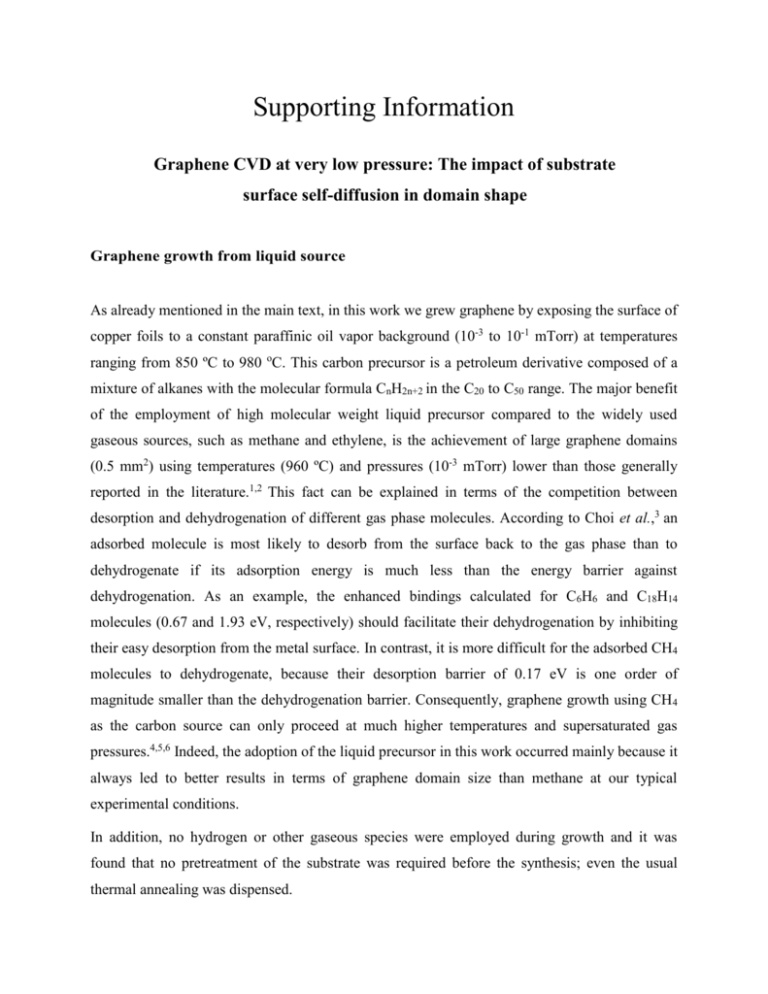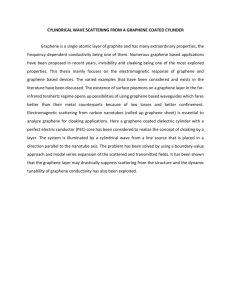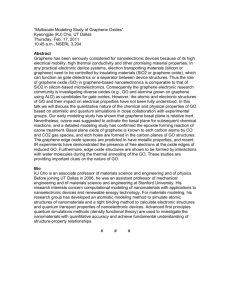SI APL-v2 - AIP FTP Server
advertisement

Supporting Information Graphene CVD at very low pressure: The impact of substrate surface self-diffusion in domain shape Graphene growth from liquid source As already mentioned in the main text, in this work we grew graphene by exposing the surface of copper foils to a constant paraffinic oil vapor background (10-3 to 10-1 mTorr) at temperatures ranging from 850 ºC to 980 oC. This carbon precursor is a petroleum derivative composed of a mixture of alkanes with the molecular formula CnH2n+2 in the C20 to C50 range. The major benefit of the employment of high molecular weight liquid precursor compared to the widely used gaseous sources, such as methane and ethylene, is the achievement of large graphene domains (0.5 mm2) using temperatures (960 ºC) and pressures (10-3 mTorr) lower than those generally reported in the literature.1,2 This fact can be explained in terms of the competition between desorption and dehydrogenation of different gas phase molecules. According to Choi et al.,3 an adsorbed molecule is most likely to desorb from the surface back to the gas phase than to dehydrogenate if its adsorption energy is much less than the energy barrier against dehydrogenation. As an example, the enhanced bindings calculated for C6H6 and C18H14 molecules (0.67 and 1.93 eV, respectively) should facilitate their dehydrogenation by inhibiting their easy desorption from the metal surface. In contrast, it is more difficult for the adsorbed CH4 molecules to dehydrogenate, because their desorption barrier of 0.17 eV is one order of magnitude smaller than the dehydrogenation barrier. Consequently, graphene growth using CH4 as the carbon source can only proceed at much higher temperatures and supersaturated gas pressures.4,5,6 Indeed, the adoption of the liquid precursor in this work occurred mainly because it always led to better results in terms of graphene domain size than methane at our typical experimental conditions. In addition, no hydrogen or other gaseous species were employed during growth and it was found that no pretreatment of the substrate was required before the synthesis; even the usual thermal annealing was dispensed. Figure S1 - Hillock formation during graphene growth at 980 ºC on Cu(311). (Ptotal= 8x10-6 Torr) Figure S2 SEM image of graphene domains at different stages (T = 950oC). Due to large deviations in nucleation time, various phases of growth can be observed in the same sample. The scale bar in the inset is 200 nm. Figure S3 - Schematic view of the proposed growth model. Ds is the surface diffusion tensor, τs is the life time of an atom in a state of mobile adsorption, 𝑲 is the kinectic coefficient which give a measure of how ease adatoms coming from the lower terrace can stick to the growing edge. References 1 Reina, A.; Jia, X.; Ho, J.; Nezich, D.; Son, H.; Bulovic ,V.; Dresselhaus,M.; Kong ,J.; Large area, few - layer graphene films on arbitrary substrates by chemical vapor deposition. Nano Lett. 2009, 9, 30-5. 2 Li, X.; Magnuson, C. W.; Venugopal, A.; An, J.; Suk, J. W.; Han,B.; Borysiak, M.; Cai, W.; Velamakanni, A.; Zhu, Y.; Fu, L.; Vogel, E.M.; Voelkl, E.; Colombo, L.; Ruoff, R. S. Graphene Films with Large Domain Size by a Two-Step Chemical Vapor Deposition Process. Nano Lett 2010, 10, 4328-34. 3 Choi, J-H.; Li, Z.; Cui, P.; Fan, X.; Zhang, H.; Changgan, Z.; and Zhang, Z. Drastic Reduction in the Growth Temperature of Graphene on Copper Via Enhanced London Dispersion Force. Scientific Reports 2012 , 3. 4 Guermoune, A.; Chari, T.; Popescu, F.; Sabri, S. S.; Guillemette, J.; Skulason, H. S.; Szkopek, T.; Siaj, M. Chemical Vapor Deposition Synthesis of Graphene on Copper. CARBON 2011, 49, 4204–4210. 5 Dong, X.; Wang, P.; Fang, W.; Su, C.-Y.; Chen, Y.-H.; Li, L.-J.; et al. Growth of Large-Sized Graphene Thin-films by Liquid Precursor-Based Chemical Vapor Deposition under Atmospheric Pressure. Carbon 2011, 49, 3672-8. 6 Wu, T.; Ding, G.; Shen, H.; Wang, H.; Sun, L.; Jiang, D.; Xie, X.; and Jiang, M. Triggering the Continuous Growth of Graphene Toward Millimeter-Sized Grains. Advanced Functional Materialsn 2013, 23, 198–203.





